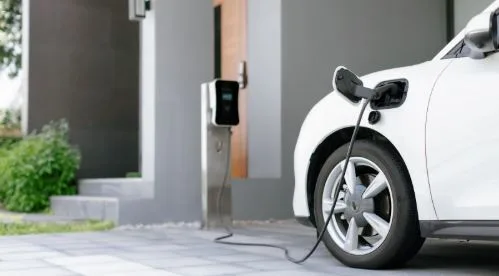How Does an EV Charger Work?
Electric vehicles are becoming more common, and with that comes a rising need to understand how EV chargers work. Whether you already own an electric car or you’re just curious, learning how these systems operate can help you make better decisions about charging at home or on the road. You might’ve even searched for ev charger installation near me after considering the switch to an EV.
At first glance, an EV charger looks like a simple device. But what it actually does is manage complex electrical currents and safely transfer energy from your home or a public grid into your car’s battery.
EV Chargers vs. Gas Pumps
Most people are used to the simplicity of a gas station. You pull up, swipe a card, and fuel flows into your tank. An EV charger doesn’t work quite the same way. It’s more like plugging in your phone, just on a much larger scale. But that comparison doesn’t cover the full story.
An EV charger must convert AC power from the grid into DC power for the battery. Some vehicles can do this conversion internally, while others rely on the charger itself to handle it. That’s where different charger types come in.
The Three Levels of Charging
EV chargers are generally grouped into three levels, each with different capabilities. These levels determine how fast your vehicle will charge.
Level 1: Basic Charging
This level uses a standard 120-volt household outlet. It’s the slowest option, adding about 3 to 5 miles of range per hour. It’s great for plug-in hybrids or for people who only drive short distances each day. No special equipment is needed, which makes it convenient, but it’s not practical for full EVs with large batteries.
Level 2: Faster Home and Public Charging
Level 2 chargers use a 240-volt power supply, like the one used by dryers or ovens. They can charge most EVs fully overnight, providing around 20 to 60 miles of range per hour. These chargers are common in homes, workplaces, and public lots. Most home EV owners install a Level 2 charger for regular use.
Level 3: DC Fast Charging
Also known as DCFC or fast charging, Level 3 chargers skip the internal converter and send DC power directly to the car’s battery. These are the ones found at highway rest stops and high-traffic urban areas. They can add 100+ miles of range in just 20 minutes. Not every EV can use a Level 3 charger though, and these stations cost significantly more to install.
The Role of the Onboard Charger
Your EV has something inside it called an “onboard charger.” Despite the name, it doesn’t supply power. It’s actually a circuit that converts incoming electricity from the wall into the right format and voltage for your battery.
When you plug your car in, the onboard charger manages the flow of power to prevent overheating, short circuits, or overcharging. It also communicates with the charging station to verify safety before power even starts flowing.
This communication is important. The cable might look simple, but there’s a data connection running through it that makes sure everything is aligned before the current starts to move.
Smart Charging Technology
Modern EV chargers often come with smart features. These include apps that let you start or stop charging remotely, schedule sessions when electricity is cheaper, or even adjust power levels automatically based on your home’s usage.
Smart chargers also connect to your utility grid in some places. This means they can lower power during peak times, which helps prevent blackouts and can save you money on energy bills.
Some smart chargers even offer vehicle-to-grid (V2G) technology, where your EV can send power back to the grid. It’s still an emerging field, but in the future, your parked car could help stabilize local electricity demand.
Charging at Home
For most EV owners, home charging is the most convenient. After all, you park your car every night, so you may as well plug it in.
Installing a Level 2 charger usually requires a dedicated 240-volt circuit, which means hiring a licensed electrician. Most homes can accommodate this setup, but older houses may need a panel upgrade.
It’s worth noting that not all chargers are created equal. Some deliver more power than others, and the cables vary in length and durability. Wall-mounted units are the most common, but there are also portable options that can go with you if you travel or move frequently.
Public Charging Networks
When you’re out and about, you’ll likely rely on public chargers. These are operated by networks like ChargePoint, Electrify America, EVgo, or Tesla Superchargers (if your vehicle is compatible).
Each network has its own pricing model, app, and access requirements. Some charge by the minute, others by the kilowatt-hour, and some even offer flat rates or subscriptions.
The availability of charging stations has improved a lot, but in certain rural or suburban areas, options can still be limited. Planning your route with a charging app is a good idea if you’re taking a long drive.
Charging Speed Depends on Several Factors
Even with a high-powered charger, your car might not always charge at maximum speed. The actual rate depends on:
- Your car’s maximum onboard charging capacity
- The charger’s output power
- Battery temperature (colder batteries charge slower)
- The battery’s current state of charge (charging slows as it nears full)
- Any limits imposed by smart charging or utility load
So if you plug into a fast charger and it doesn’t deliver full speed, the issue might be with your car’s settings or condition, not the station.
Safety Is a Top Priority
EV chargers are designed with multiple safety layers. From ground fault detection to thermal monitoring, these devices are engineered to prevent dangerous situations. If something goes wrong, the charger automatically shuts off power before any harm is done.
Still, professional installation is crucial. A poor setup could create fire risks, damage your car, or void its warranty. That’s why it’s important to work with certified electricians or contractors familiar with EV systems.
A Quick Look at Charging Connectors
Not all EVs use the same plug. In North America, the main connector types include:
- J1772: Standard for Level 1 and Level 2 charging
- CCS (Combined Charging System): Standard for DC fast charging on most non-Tesla vehicles
- CHAdeMO: Used by some Nissan and Mitsubishi vehicles, though becoming less common
- Tesla Connector: Exclusive to Tesla vehicles, though adapters are available for others
Some newer EVs are shifting toward a North American Charging Standard (NACS), which Tesla originally developed. Over time, more brands may adopt this as a universal plug type.
The Future of EV Charging
As EVs become more popular, charging infrastructure will continue to grow. Wireless charging pads, ultra-fast stations, solar-powered units, and AI-optimized grid interaction are already in development or testing phases.
We’re not far from a time where you might park your car and have it charge itself without cables. Or where your EV powers your house during a storm.
Final Thoughts
Understanding how EV chargers work doesn’t require an electrical engineering degree, but it helps to know the basics. From power levels to plug types and smart features, there’s more going on than just plugging something in.
If you’re planning to install one at home, or just want to make the most of public charging, learning how it all fits together can save you time, money, and frustration down the line.




